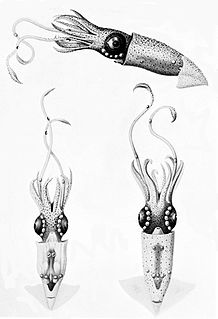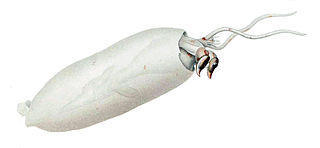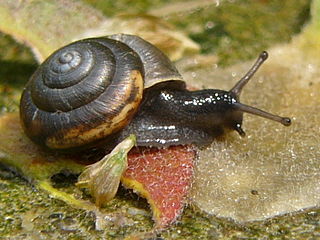
The Lycoteuthidae are a family of squid comprising four known genera in two subfamilies. They are small muscular squid characterised by a lack of hooks and by photophores present on the viscera, eyeballs and tentacles. They inhabit tropical and subtropical seas where the diel migrants which stay down in the mesopelagic zone during the day and migrate to the surface to feed at night. Some species show strong sexual dimorphism.

The Mastigoteuthidae, also known as whip-lash squid, are a family of small deep-sea squid. Approximately 20 known species in six genera are represented, with members found in both the mesopelagic and bathypelagic zone of most oceans. Originally described by Verill in 1881, it was later lowered by Chun (1920) to a subfamily (Mastigoteuthinae) of the Chiroteuthidae. However, Roper et al. (1969) raised it back to the family level, and this has not been changed since. The taxonomy of this family is extremely unstable, and there have been at times one genus, two genera and four subgenera(Salcedo-Vargas & Okutani, 1994), two genera and several 'groups', five genera and one species with an uncertain placement, or six genera.

Histioteuthidae is a family of Oegopsid squid. The family was previously considered to be monotypic but the World Register of Marine Species assigns two genera to this family.

Lycoteuthis is a genus containing two species of squid: Lycoteuthis springeri and Lycoteuthis lorigera. They are small animals which grow up to 8 cm in length.

Abralia is a genus of squid comprising around 20 species from the family Enoploteuthidae. They are small squid which can be found in the epipelagic to mesopelagic zones while some species are found in water with shallow substrates on steep slopes on the boundary of the mesopelagic zone. They are distinguished from other members of the Enoploteuthidae by not normally having large, black photophores at the tips of arms IV, although if these are present they are not covered in black chromatophores, and having fins which extend beyond their tail. The photophores of the integument are characteristicand are found in the three types. "Lensed" photophores are a blue color with a white ring, "simple" photophores are small and violet-colored and the "complex" photophores are surrounded by small green satellite points and have a green centre. The complex photophores will frequently appear to be blue depending on their physiological state. The integument also has small black chromatophores which look like dots. They have 5-12 variably sized photophores on the eye. Either the right or left arm IV is hectocotylized.

Octopus is the largest genus of octopuses, comprising more than 100 species. These species are widespread throughout the world's oceans. Many species formerly placed in the genus Octopus are now assigned to other genera within the family Octopodidae.

Cranchiinae is a subfamily containing four genera of glass squids.

Taoniinae is a subfamily containing ten genera of glass squids.

Euprymna is a genus of bobtail squid comprising a number of species.

Hygromiidae is a taxonomic family of small to medium-sized air-breathing land snails, terrestrial pulmonate gastropod mollusks in the superfamily Helicoidea.

The Littorinidae are a taxonomic family of over 200 species of sea snails, marine gastropod molluscs in the clade Littorinimorpha, commonly known as periwinkles and found worldwide.

Eulimidae is a family of very small parasitic sea snails, marine gastropod mollusks in the superfamily Vanikoroidea.

Gemmula, common name the gem turrids, is a genus of sea snails, marine gastropod mollusks in the family Turridae, the turrids.

Ergalataxinae is a taxonomic subfamily of small to medium-sized predatory sea snails, marine gastropod mollusks within the family Muricidae, the rock snails. In this subfamily, the aragonitic shell has 0–2 varices.

Teuthowenia megalops, sometimes known as the Atlantic cranch squid, is a species of glass squid from the subarctic and temperate waters of the northern Atlantic Ocean. They are moderately sized squid with a maximum mantle length of 40 cm (16 in). Their very large eyes are the source for the specific name megalops. Like other members of the genus Teuthowenia, they are easily recognizable by the presence of three bioluminescent organs (photophores) on their eyeballs.

Muusoctopus is a cosmopolitan genus of deep-sea octopi from the family Enteroctopodidae. These are small to medium-sized octopuses which lack an ink sac. Recent work has suggested that these octopuses originated in the North Atlantic and subsequently moved into the North Pacific while the species in the Southern Hemisphere are descended from multiple invasions from northern oceans.

Lampadioteuthis megaleia is a small, colorful squid from the family Lycoteuthidae, it is the only species in the only genus in the monotypic subfamily Lampadioteuthinae, it is sometimes known as the wonderful firefly squid. It differs from the other species of the Lycoteuthidae mainly by having a hectocotylus in the males and by the possession of a rostrum on the gladius.
Nematolampas is a genus of squid from the family Lycoteuthidae. The genus comprises two species both of which are known from only a few males. The type species, Nematolampas regalis has been recorded from the subtropical South Pacific and the second species, Nematolampas venezuelensis, is from the tropical western North Atlantic. The main distinguishing feature of this genus is that arms III are very elongated and thread-like and have no suckers near their tips. As only males have been captured it is not known if this feature is present in females.
Lycoteuthis springeri is a small species of rarely captured squid from the family Lycoteuthidae. It has three photophores on the posterior portion of the abdomen and the males have a long tail which bears seven deeply embedded long and thin photophores. The males also have photophores on arms II and III, as well as on the head and the mantle. The tentacular clubs and the structure of the suckers on the club and arm are not distinctive. Two of the known specimens were males which had mantle lengths of 80mm and 97mm. The type locality was in the Gulf of Mexico and the holotype was found in the stomach of a shark which was captured at 367m.
Nematolampas regalis, the regal firefly squid is a small, little known species of squid from the family Lycoteuthidae which is found in the subtropical South Pacific Ocean. This squid has a mantle length of 30mm. It may be sexually dimorphic with the males possibly having very thin elongated arms III which are increasingly thread like towards their tips where they do not have any suckers. Arms II are "normal" and have suckers along their length. The third arms have a series of photophores along their length and there is a small photophore located on each of the tips of arms I and II. The tentacles have two embedded photophores and the largest of the eye's photophores is in the centre. There is a pair of large photophores vlose to the tip of the mantle on the ventral side mantle; with no other photphores on the body except for a visceral photophore which is also near the tip. There is practically no tail. N. regalis is known only from the Kermadec Islands near New Zealand, one of the specimens was beached while the other two were caught by a trawl at a depth of 48m.
















